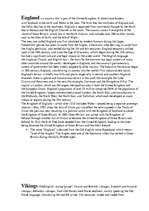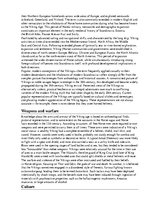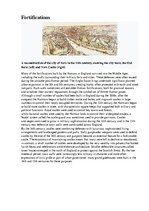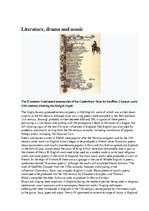-
Culture in England
The Romanesque All Saints' Church, Brixworth, late 7th–8th century
In the century after the collapse of the Romano-British economy, very few substantial buildings were constructed and many villas and towns were abandoned. New long- and round-houses were constructed in some settlements, while in others timber buildings were built imitating the older Roman styles. The Germanic immigrants constructed small rectangular buildings from wood, and occasionally grander halls. However, the conversion to Christianity in the 6th and 7th centuries reintroduced Italian and French masons, and these craftsmen built stone churches, low in height, following a narrow, rectangular plan, plastered inside and fitted with glass and colourful vestments. This Romanesque style developed throughout the period, featuring characteristic circular arches. By the 10th and 11th centuries, much larger churches and monastery buildings were being built, featuring square and circular towers after the contemporary European fashion. The palaces constructed for the nobility centred on great timber halls, while manor houses began to appear in rural areas.
The Normans brought with them architectural styles from their own duchy, where austere stone churches were preferred. Under the early Norman kings this style was adapted to produce large, plain cathedrals with ribbed vaulting. During the 12th century the Anglo-Norman style became richer and more ornate, with pointed arches derived from French architecture replacing the curved Romanesque designs; this style is termed Early English Gothic and continued, with variation, throughout the rest of the Middle Ages. In the early 14th century the Perpendicular Gothic style was created in England, with an emphasis on verticality, immense windows and soaring arcades. Fine timber roofs in a variety of styles, but in particular the hammerbeam, were built in many English buildings. In the 15th century the architectural focus turned away from cathedrals and monasteries in favour of parish churches, often decorated with richly carved woodwork; in turn, these churches influenced the design of new chantry chapels for existing cathedrals.
…
(13-15 century) England is a country that is part of the United Kingdom. It shares land borders with Scotland to the north and Wales to the west. The Irish Sea lies northwest of England and the Celtic Sea lies to the southwest. England is separated from continental Europe by the North Sea to the east and the English Channel to the south. The country covers five-eighths of the island of Great Britain, which lies in the North Atlantic, and includes over 100 smaller islands, such as the Isles of Scilly and the Isle of Wight.











